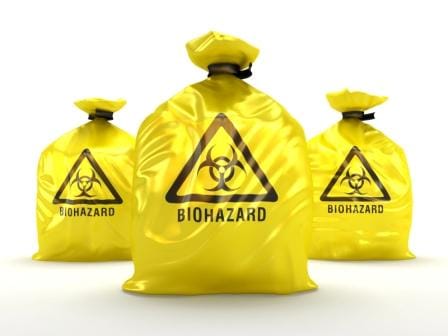Hazardous Biological Agents Assessments
Pathogenic microorganisms may be hazardous at extremely low concentrations, and of course biological agents are not visible to the naked eye. Even if no biological agent is detected, it is possible for micro-organisms to provoke a toxic or allergic effect via their metabolites (mycotoxins or their component endotoxins). Unlike other dangerous substances, biological agents can reproduce. Under favourable conditions, a small number of micro-organisms may multiply in a very short time to create a considerable problem.
Hazardous biological agents, as defined under the Regulations for Hazardous Biological Agents, OHS Act (85 of 1993), means any microorganism, cell culture or human endoparasite, including any which have been genetically modified, which may cause any infection, allergy, or toxicity, or otherwise create a hazard to human health.
The European directive 2000/54/CE divides biological hazards (pathogens) into four groups, based on the inherent hazard of the organism. (This classification refers only to the level of infection risk of the biological agent concerned.):
- Group 1 — Unlikely to cause human disease.
- Group 2 — Can cause human disease and might be a hazard to workers; unlikely to spread to the community; there is usually effective prophylaxis or treatment available.
- Group 3 — Can cause severe human disease and present a serious hazard to workers; it may present a risk of spreading to the community, but there is usually effective prophylaxis or treatment available.
- Group 4 — Causes severe human disease and is a serious hazard to workers; it may present a high risk of spreading to the community; there is usually no effective prophylaxis or treatment available.
Persons at work may be infected by hazardous biological agents via various routes of transmission. These include physical contact, droplet transmission, airborne transmission, as well as vector-borne and common vehicle transmission.
Biological agents include bacteria, fungi, viruses, other microorganisms and their associated toxins. They are widespread in the natural environment and are found in soil, water, animals and plants. Because many microbes reproduce rapidly and require minimal resources for survival, they are a potential danger in a wide variety of occupational settings.
Employees in food production, farming, agriculture, hospitals and laboratories, municipality (refusal and sewage workers) are considered most at risk. In addition, exposure in office buildings to the following is also considered to increase risk:
- Carpets.
- Wallpaper.
- Damp areas.
- Ventilation systems.
Infection at the workplace can occur via different sources such as:
- Blood and other body fluids.
- Human bodies, animal carcasses and raw meat.
- Human or animal waste products such as faeces and urine.
- Respiratory discharges such as coughs and sneezes.
- Skin contact.
Allergic and toxic reactions can occur via:
- Moulds or mould spores.
- Dust mites, feathers, animal hairs, pollen.
Exposure to hazardous biological agents in the workplace is governed by the Regulations for Hazardous Biological Agents, OHS Act (85 of 1993), and requires that employers must:
- Carry out occupational monitoring surveys in the workplace.
- Conduct a risk assessment survey and monitoring every two years.
- Implement engineering control measures, administrative control measures and/or use of personal protective equipment and facilities to prevent or, where this is not reasonably practicable, adequately control the exposure risk presented to employees.
Strat Environment can assist clients to comply with statutory requirements at their workplace, by conducting onsite inspections and assisting with the implementation of preventative measures to ensure the maintenance of adequate control over the exposure of employees.
Strat Environment provide clients with several hazardous biological agent surveys that include:
- Occupational health evaluation of drinking water and provision of a comprehensive report on completed surveys.
- Evaluation of effluent water.
- Evaluation of legionella counts in other water sources and in air-conditioning systems.
- Biological monitoring survey of equipment and food contact surfaces in food premises.
Learn more about some hazardous biological agents issues that can be addressed, by signing up for an official assessment from Strat Environment.
Sources:
http://www.osha.mddsz.gov.si/resources/files/pdf/53_risk-assessment-biological-agents.pdf
https://www.nioh.ac.za/fact-sheets/hazardous-biological-agents/

